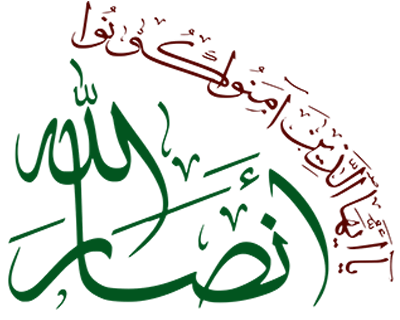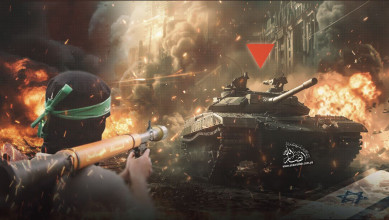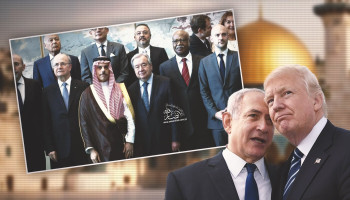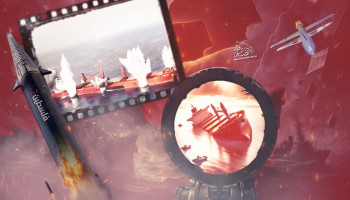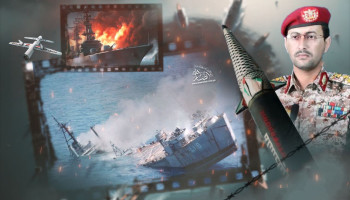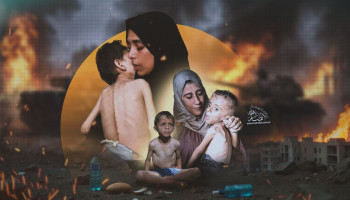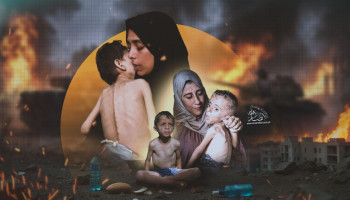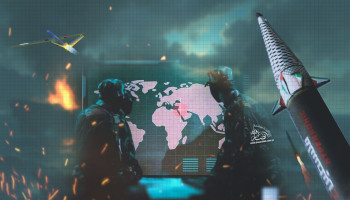Published: Muharram 14, 1447 AH
Beit Hanoun is fighting as if it were all of Gaza. The northern town has not known sleep since the dawn of the al-Aqsa flood. It fights moment by moment, as though it alone carries the banner of revolution. Today, it wrote a new chapter—one crafted with fire, ambushes, and calculated tactics.
In a scene reflecting the pinnacle of combat ingenuity, resistance units orchestrated a complex fire ambush in the vicinity of Beit Hanoun. Carefully rigged explosive devices, RPG ambushes, and tactical luring of the Zionist forces into a deadly trap were all employed.
The battle rages on in Beit Hanoun. The Palestinian resistance continues to engage in fierce confrontations with Israeli occupation forces. According to the enemy’s admission, five Zionist soldiers were killed and over sixteen were wounded.
According to preliminary investigations, the incident took place during a joint military operation led by two Zionist brigades in Beit Hanoun, just opposite the town of "Sderot" in northern Gaza. The town has been captured and attacked repeatedly throughout the aggression. On Saturday evening, another assault was launched by the Zionist enemy’s Northern Brigade and the 646th Reserve Brigade, aiming to storm the area and "cleanse" it of resistance fighters. Beit Hanoun had been under siege from all directions.
The incident began shortly after 10:00 p.m. on Monday, when troops from the Israeli "Netzah Yehuda" Battalion—the Zionist enemy’s first ultra-Orthodox combat unit—proceeded on foot as part of the operation. Two explosive devices were detonated one after the other along their route. Despite intense aerial bombardments in recent weeks intended to "soften" the area in preparation for the assault, the explosives detonated precisely as the infantry unit passed.
During the evacuation of the wounded from the explosion site, resistance fighters opened fire from a concealed position, inflicting further losses on the rescue teams. As additional forces were dispatched to extract the injured, they too fell into the trap.
A deadly blow against Zionist forces after 21 months of a brutal war backed by the United States stands as a testament to the failure of this genocidal campaign to break the will of the Palestinian resistance. The people continue to resist among the rubble of their bombed homes, targeted by airstrikes, artillery shells, and explosive-laden robots. Yet the spirit of resistance remains unbroken.
The Beit Hanoun ambush delivered a profound shock to the Zionist military leadership and intelligence, who had repeatedly claimed the defeat of Beit Hanoun’s battalion. Each time, however, the town returns to write legendary tales of heroism and resilience, sending the enemy back bloodied, dragging the remains of its soldiers and destroyed machinery.
The ambush demonstrated superior intelligence, impeccable camouflage, and precise timing. It confirmed that the resistance still controls the battlefield by its own rules, not those of the occupier. The coordinated use of explosives, RPGs, and the preemptive destruction of an engineering robot shows a deep understanding of Israeli tactics and a mastery of operational timing.
The location of the operation speaks volumes—Beit Hanoun, cut off from the world for months, supposedly neutralized by Israeli forces as early as the third month of the war. And yet, a carefully placed explosive targeted an armored vehicle. The Qassam Brigades know well which vehicles carry officers and which carry soldiers—previous footage confirms this fact.
A ready-to-detonate robot was also destroyed—a rare opportunity seized amid a crowd of Israeli troops who believed they were safe.
The timing is equally significant: the ambush coincided with heated negotiations between the resistance and the Zionist entity. It was a move meant to increase pressure and strengthen the resistance’s bargaining position. Zionist media reported this week that Hamas now understands the Israeli army’s operational patterns. The operation served not only as a blow in the field but as a message in the negotiating room.
Ultimately, Israel must fear every large-scale operation it launches in Gaza. In every corner and alleyway, it will find deadly resistance waiting.
The Zionist army radio reported that "according to all senior commanders in Gaza, IEDs represent the most serious threat to our forces in the Strip." Statistics revealed that over 70% of Zionist casualties in Gaza in recent months have been caused by IEDs. Out of 38 deaths since March 18, 27 were attributed to explosives.
IEDs come in two forms: road ambushes, which killed 19 soldiers, and booby-trapped buildings, which killed 6 others. In recent weeks, the Israeli army has observed growing boldness among Hamas fighters. Unlike before, they no longer plant IEDs and detonate them remotely—they now emerge from the rubble, fight directly, and fire from within the ambush, knowing full well the risks.
The most lethal confrontations for Israeli forces recently involved fighters staying on-site after the ambush to continue the battle—even against the rescue teams—to maximize their impact.
The fighters also rely heavily on photography, capturing high-quality, multi-angle footage of their operations, which Hamas later publishes as part of its media strategy.
Beit Hanoun is not defined by its size, but by the hearts of its defenders. Its story is told in the ashes of its homes and the glow of tears. The town has been emptied of its civilians for months. Those remaining are besieged, without water, bread, or medicine. Yet they stand tall, like palm trees in a merciless storm.
Beit Hanoun is no longer just a town in northern Gaza. It has become a divine symbol, a shrine of martyrdom, an icon etched on the face of the earth. Its rubble does not complain; it sings: “Here passed the heroes, and here they ascended.”
Allah’s mercy is evident there, like dawn after a long night, and the heavens continue to send their messages.
From the slingshot of history came David’s stones, carrying certainty in their core and pride in their grasp. From the ashes of modern wars, resistance fighters emerged—the true people of the land, armed with rifles and an unbreakable right. David’s stones are not mere rocks—they are divine promises of tyranny’s end, a prophecy that renews in every era.
Today, the scene repeats: the tank advances, the skies rain fire—but there stands someone, bare-chested, firmly rooted, hurling truth into the face of falsehood. In Gaza, Khan Younis, Jabalia, and even Jenin—David’s stones are translated into bullets, and cries of victory are born from genocide and hunger.
There is no difference between a slingshot and a rifle when wielded by the hand of faith and the heart that knows no defeat, against the same blind oppressor who believes iron will decide the battle.
Let the tyrants know: from the slingshot of history to the rifle of today, David’s stones continue to write victory. Tyranny continues to fall before heroes who possess nothing but their will, yet a will that cannot be broken.
The Islamic Resistance Movement Hamas commented on the exceptional ambush, stating that the military and political realities—640 days into Israel’s extermination war—have become clear to the world: the occupation has utterly failed to break Gaza’s will or suppress its resistance.
Hamas declared that the slogans of “total defeat” and “complete eradication” of the movement have fallen at the doors of explosive tunnels and complex resistance ambushes. The illusion of “freeing hostages by force” has collapsed under the weight of repeated blows. Hamas affirmed that Gideon’s armored vehicles burned in Beit Hanoun and Khan Younis, killing those inside, while the heroic resistance fighters continue to fight bravely and equally—despite hunger and siege—as the occupation commits massacres against civilians and the innocent.
Abu Ubaida, spokesman for the Al-Qassam Brigades, affirmed: “The Beit Hanoun operation was another blow by our mighty fighters to the prestige of the Israeli army and its most brutal units, in a battlefield they believed secure after leveling it.” He added: “Our fighters’ war of attrition against the enemy, from the north to the south of Gaza, will cost them daily losses. If they were lucky enough to rescue some soldiers from hell recently, they might not succeed next time—perhaps, they will leave new captives in our hands.”
He stressed: “The steadfastness of the Palestinian people and the bravery of its fighters are solely what forge new equations and define the coming stage. The most foolish decision Netanyahu could make would be to keep his forces in Gaza.”
The resistance's ability to escalate its operations as it enters the 22nd month of a global war against it—coinciding with political negotiations—demonstrates a strategic effort to increase military pressure on the enemy and support its negotiating team. This can no longer be explained by military logic alone. The resistance and its political leadership are now reaping the results of spiritual, Quranic, and ideological preparation. This resilience is not measured by weaponry, but by the Jihad spirit.
This is no longer a months-long conflict. Tonight marks the start of month 22, week 92, day 640, and hour 15,000 of a war in which one side enjoys global support while the other is isolated—yet still delivers painful, deadly blows.
Beit Hanoun is not merely a battlefield—it is a living revolutionary laboratory of resistance tactics. Here, fighters do not retreat. They gain experience and redefine the very meaning of “shock” in the enemy’s mind. Beit Hanoun today embodies the spirit of the flood, the memory of combat from the first moment. Here, no white flags are raised. Instead, red banners are planted over the rubble, signaling that the battle has not ended—it has just begun anew.
